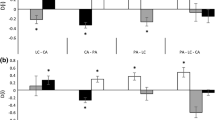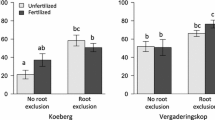Abstract
Non-native plants can have adverse effects on ecosystem structure and processes by invading and out-competing native plants. I examined the hypothesis that mature plants of non-native and native species exert differential effects on the growth of conspecific and heterospecific seedlings by testing predictions that (1) invasive vegetation has a stronger suppressive effect on seedlings than does native vegetation, (2) seedlings of invasive species are better able to grow in established vegetation than are native seedlings, and (3) invasive species facilitate conspecific and inhibit heterospecific seedling growth. I measured growth rates and interaction intensities for seedlings of four species that were transplanted into five wetland monoculture types: invasive Lythrum salicaria; native L. alatum, Typha angustifolia, T. latifolia; unvegetated control. Invasive L. salicaria had the strongest suppressive effect on actual and per-individual bases, but not on a per-gram basis. Seedlings of T. latifolia were better able to grow in established vegetation than were those of L. salicaria and T. angustifolia. These results suggest that L. salicaria is not a good invader of established vegetation, but once established, it is fairly resistant to invasion. Thus, it is likely that disturbance of established vegetation facilitates invasion by L. salicaria, allowing it to compete with other species in even-aged stands where its high growth rate and consequent production of aboveground biomass confer a competitive advantage.




Similar content being viewed by others
References
Alpert P, Bone E, Holzapfel C (2000) Invasiveness, invasibility and the role of environmental stress in the spread of non-native plants. Perspect Plant Ecol Evol Syst 3:52–66
Bakker J, Wilson SD (2001) Competitive abilities of introduced and native grasses. Plant Ecol 157:119–127
Bruce KA, Cameron GN, Harcombe PA (1995) Initiation of a new woodland type on the Texas coastal prairie by the Chinese tallow tree [ Sapium sebiferum (L.) Roxb.]. Bull Torrey Bot Club 122:215–225
Bunn SE, Davies PM, Kellaway DM, Prosser IP (1998) Influence of invasive macrophytes on channel morphology and hydrology in an open tropical lowland stream, and potential control by riparian shading. Freshwater Biol 39:171–178
Conway WC, Smith LM, Bergan JF (2002) Potential allelopathic interference by the exotic Chinese tallow tree (Sapium sebiferum). Am Midl Nat 148:43–53
D’Antonio CM (1993) Mechanisms controlling invasion of coastal plant communities by the alien succulent Carpobrotus edulis. Ecology 74:83–95
D’Antonio CM, Vitousek PM (1992) Biological invasions by exotic grasses, the grass/fire cycle, and global change. Annu Rev Ecol Syst 23:63–87
D’Antonio CM, Hughes RF, Vitousek PM (2001) Factors influencing dynamics of two invasive C4 grasses in seasonally dry Hawaiian woodlands. Ecology 82:89–104
Farnsworth EJ, Ellis DR (2001) Is purple loosestrife (Lythrum salicaria) an invasive threat to freshwater wetlands? Conflicting evidence from several ecological metrics. Wetlands 21:199–209
Galatowitsch SM, Anderson NO, Ascher PD (1999) Invasiveness in wetland plants in temperate North America. Wetlands 19:733–755
Gallardo MT, Martin BB, Martin DF (1998) An annotated bibliography of allelopathic properties of cattails, Typha spp. Environ Chem 61:52–58
Gaudet CL, Keddy PA (1988) A comparative approach to predicting competitive ability from plant traits. Nature 334:242–243
Gaudet CL, Keddy PA (1995) Competitive performance and species distribution in shoreline plant communities: a comparative approach. Ecology 76:280–291
Gerry AK, Wilson SD (1995) The influence of initial size on the competitive responses of six plant species. Ecology 76:272–279
Goldberg DE (1987) Neighborhood competition in an old-field plant community. Ecology 68:1211–1223
Goldberg DE (1990) Components of resource competition in plant communities. In: Grace JB, Tilman D (eds) Perspectives on plant competition. Academic Press, San Diego, pp 27–49
Goldberg DE, Fleetwood L (1987) Competitive effect and response in four annual plants. J Ecol 75:1131–1143
Goldberg DE, Scheiner SM (2001) ANOVA and ANCOVA: Field competition experiments. In: Scheiner SM, Gurevitch J (eds) Design and analysis of ecological experiments, 2nd edn. Oxford University Press, New York, pp 77–98
Goldberg DE, Werner PA (1983) Equivalence of competitors in plant communities: a null hypothesis and a field experimental approach. Am J Bot 70:1098–1104
Goodwin J (1992) The role of mycorrhizal fungi in competitive interactions among native bunchgrasses and alien weeds: a review and synthesis. Northwest Sci 66:251–260
Gordon DR (1998) Effects of invasive, non-indigenous plant species on ecosystem processes: lessons from Florida. Ecol Appl 8:975–989
Gordon DR, Rice KJ (1993) Competitive effects of grassland annuals on soil water and blue oak (Quercus douglasii) seedlings. Ecology 74:68–82
Grace JB, Harrison JS (1986) The biology of Canadian weeds. 73. Typha latifolia L., Typha angustifolia L. and Typha × glauca Godr. Can J Plant Sci 66:361–379
Grace JB, Wetzel RG (1981) Habitat partitioning and competitive displacement in cattails (Typha): experimental field studies. Am Nat 118:463–474
Grace JB, Keough J, Guntenspergen GR (1992) Size bias in traditional analyses of substitutive competition experiments. Oecologia 90:429–434
Hager HA (2003) Invasion dynamics of Lythrum salicaria L. PhD thesis, University of Regina, Saskatchewan, Canada
Hobbie SE (1992) Effects of plant species on nutrient cycling. Trends Ecol Evol 7:336–339
Holmes PM, Cowling RM (1997) The effects of invasion by Acacia saligna on the guild structure and regeneration capabilities of South African fynbos shrublands. J Appl Ecol 34:317–332
Howard TG (2001) The relationship of total and per-gram rankings in competitive effect to the natural abundance of herbaceous perennials. J Ecol 89:110–117
Howard TG, Goldberg DE (2001) Competitive response hierarchies for germination, growth, and survival and their influence on abundance. Ecology 82:979–990
Huenneke LF, Thomson JK (1995) Potential interference between a threatened endemic thistle and an invasive nonnative plant. Conserv Biol 9:416–425
Johnson LC, Damman AWH (1991) Species-controlled Sphagnum decay on a South Swedish raised bog. Oikos 61:234–242
Keddy P, Fraser LH, Wisheu IC (1998) A comparative approach to examine competitive response of 48 wetland plant species. J Veg Sci 9:777–786
Mack MC, D’Antonio CM (1998) Impacts of biological invasions on disturbance regimes. Trends Ecol Evol 13:195–198
Mack MC, D’Antonio CM, Ley RE (2001) Alteration of ecosystem nitrogen dynamics by exotic plants: a case study of C4 grasses in Hawaii. Ecol Appl 11:1323–1335
Mack RN, Simberloff D, Lonsdale WM, Evans H, Clout M, Bazzaz FA (2000) Biotic invasion: causes, epidemiology, global consequences, and control. Ecol Appl 10:689–710
Makepeace W, Dobson AT, Scott D (1985) Interference phenomena due to mouse-ear and king devil hawkweed. N Z J Bot 23:79–90
Mal TK, Lovett-Doust J, Lovett-Doust L (1997) Time-dependent competitive displacement of Typha angustifolia by Lythrum salicaria. Oikos 79:26–33
Malecki RA, Rawinski TJ (1985) New methods for controlling purple loosestrife. N Y Fish Game J 32:9–19
Meekins JF, McCarthy BC (1999) Competitive ability of Alliaria petiolata. Int J Plant Sci 160:743–752
Miller TE, Werner PA (1987) Competitive effects and responses between plant species in a first-year old-field community. Ecology 68:1201–1210
Nernberg D, Dale MRT (1997) Competition of five native prairie grasses with Bromus inermis under three moisture regimes. Can J Bot 75:2140–2145
O’Hare NK, Dalrymple GH (1997) Wildlife in southern Everglades wetlands invaded by melaleuca (Melaleuca quinquenervia). Bull Florida Mus Nat Hist 41:1–68
Peltzer DA, Köchy M (2001) Competitive effects of grasses and woody plants in mixed-grass prairie. J Ecol 89:519–527
Peltzer DA, Wilson SD, Gerry AK (1998) Competition intensity along a productivity gradient in a low-diversity grassland. Am Nat 151:465–476
Rachich J, Reader RJ (1999) An experimental study of wetland invasibility by purple loosestrife (Lythrum salicaria). Can J Bot 77:1499–1503
Reader RJ, Bonser SP (1993) Control of plant frequency on an environmental gradient: effects of abiotic variables, neighbours, and predators on Poa pratensis and Poa compressa (Gramineae). Can J Bot 71:592–597
Reader RJ, Wilson SD, Belcher JW, Wisheu I, Keddy PA, Tilman D, Morris EC, Grace JB, McGraw JB, Olff H, Turkington R, Klein E, Leung Y, Shipley B, van Hulst R, Johansson ME, Nilsson C, Gurevitch J, Grigulis K, Beisner BE (1994) Plant competition in relation to neighbor biomass: an intercontinental study with Poa pratensis. Ecology 75:1753–1760
Rogers HM, Hartemink AE (2000) Soil seed bank and growth rates of an invasive species, Piper aduncum, in the lowlands of Papua New Guinea. J Trop Ecol 16:243–251
SanLeón DG, Izco J, Sánchez JM (1999) Spartina patens as a weed in Galician saltmarshes (NW Iberian Peninsula). Hydrobiologia 415:213–222
Shadel WP, Molofsky J (2002) Habitat and population effects on the germination and early survival of the invasive weed, Lythrum salicaria L. (purple loosestrife). Biol Inv 4:413–423
Shamsi SRA, Whitehead FH (1974) Comparative eco-physiology of Epilobium hirsutum L. and Lythrum salicaria L. II. Growth and development in relation to light. J Ecol 62:631–645
Shipley B, Keddy PA, Moore DRJ, Lemky K (1989) Regeneration and establishment strategies of emergent macrophytes. J Ecol 77:1093–1110
Steel RGD, Torrie JH (1980) Principles and procedures of statistics: a biometrical approach. 2nd edn. McGraw-Hill, New York
Stuckey RL (1980) Distributional history of Lythrum salicaria (purple loosestrife) in North America. Bartonia 47:3–20
Thimijan R, Heins R (1983) Photometric, radiometric, and quantum light units of measure: a review of procedures for interconversion. HortScience 18:818–822
Thompson DQ, Stuckey RL, Thompson EB (1987) Spread, impact, and control of purple loosestrife (Lythrum salicaria) in North American wetlands. United States Department of the Interior Fish and Wildlife Service, Washington, D.C.
Thompson K, Hodgson JG, Grime JP, Burke MJW (2001) Plant traits and temporal scale: evidence from a 5-year invasion experiment using native species. J Ecol 89:1054–1060
Treberg M, Husband B (1999) Relationship between the abundance of Lythrum salicaria (purple loosestrife) and plant species richness along the Bar River, Canada. Wetlands 19:118–125
Vitousek PM, Walker LR, Whittacker LD, Mueller-Dombois D, Matson PA (1987) Biological invasion by Myrica faga alters ecosystem development in Hawaii. Science 238:802–804
Wardle DA, Nicholson KS, Ahmed M, Rahman A (1994) Interference effects of the invasive plant Carduus nutans L. against the nitrogen fixation ability of Trifolium repens L. Plant Soil 163:287–297
Weigelt A, Steinlein T, Beyschlag W (2002) Does plant competition intensity rather depend on biomass or on species identity? Basic Appl Ecol 3:85–94
Weihe PE, Neely RK (1997) The effects of shading on competition between purple loosestrife and broad-leaved cattail. Aquat Bot 59:127–138
Weiher E, Keddy PA (1995) The assembly of experimental wetland plant communities. Oikos 73:323–335
Weiher E, Wisheu IC, Keddy PA, Moore DRJ (1996) Establishment, persistence, and management implications of experimental wetland plant communities. Wetlands 16:208–218
Welling CH, Becker RL (1993) Reduction of purple lossestrife establishment in northern wetlands. Wildl Soc Bull 21:56–64
Wetzel PR, van der Valk AG (1998) Effects of nutrient and soil moisture on competition between Carex stricta, Phalaris arundinacea, and Typha latifolia. Plant Ecol 138:179–190
Wilson JB, Agnew ADQ (1992) Positive-feedback switches in plant communities. Adv Ecol Res 23:263–336
Wilson SD, Keddy PA (1986) Species competitive ability and position along a natural stress/disturbance gradient. Ecology 67:1236–1242
Wilson S, Keddy PA (1991) Competition, survivorship and growth in macrophyte communities. Freshwater Biol 25:331–337
Zar JH (1984) Biostatistical analysis, 2nd edn. Prentice Hall, New Jersey
Acknowledgements
Many thanks for assistance in the field: Sarah Yakimowski, Fiona Goorman, Rachelle McGregor, Tyler Cobb, Angela Strecker, Kathryn Yurkonis, Bethany Rector, Ivana Rósova and Brent Lee from Carlos Avery. Rolf Vinebrooke, Mary Vetter, Liesbeth Bakker and two reviewers provided helpful comments on the manuscript. The following agencies provided funds: NSERC, Regina Natural History Society, Saskatchewan Environment and Resource Management, University of Regina; a home for the experiment: Carlos Avery Wildlife Management Area–Minnesota Department of Natural Resources; and accommodations: Cedar Creek Natural History Area.
Author information
Authors and Affiliations
Corresponding author
Rights and permissions
About this article
Cite this article
Hager, H.A. Competitive effect versus competitive response of invasive and native wetland plant species. Oecologia 139, 140–149 (2004). https://doi.org/10.1007/s00442-004-1494-6
Received:
Accepted:
Published:
Issue Date:
DOI: https://doi.org/10.1007/s00442-004-1494-6




